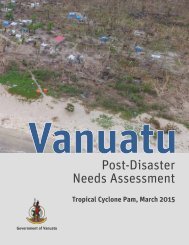Fiji
yqgk302EGjo
yqgk302EGjo
Create successful ePaper yourself
Turn your PDF publications into a flip-book with our unique Google optimized e-Paper software.
FIJI Post-Disaster Needs Assessment<br />
Intangible Cultural Heritage: The sustainability of traditional knowledge and intangible heritage of local cultures rests on<br />
the transmission of the latter from the bearer or keeper to the younger generation. Intangible Cultural Heritage defines the<br />
culture of the <strong>Fiji</strong>an people, and research and documentation in <strong>Fiji</strong>’s 14 provinces helps in the continuity of age old cultures<br />
and traditions. The data is stored in the Ministry of iTaukei Affairs’ National iTaukei Database for Traditional Knowledge and<br />
Expressions (NTDTKE).<br />
Repositories of Heritage: <strong>Fiji</strong> has a collection of built repositories housing numerous collections of art, artefacts and<br />
documentary heritage, among others, 12 of which were identified for assessment, including the <strong>Fiji</strong> Museum, Ba Museum,<br />
National Archives of <strong>Fiji</strong> and various art galleries.<br />
Cultural Industries: Cultural industries are important for wealth creation, growth, sustainable development and social<br />
security. <strong>Fiji</strong>an cultural industries feature local musicians, traditional handcraft, <strong>Fiji</strong> Fashion Week, <strong>Fiji</strong> visual arts, local media<br />
and advertising. The production and promotion of cultural goods and services significantly improves the quality of life of<br />
people.<br />
Assessment of Disaster Effects on the Culture and Heritage Sector (F$6 million)<br />
Culture and heritage have high symbolic value and mirror a nation incorporating elements ranging from built and intangible<br />
heritage to documentary heritage, repositories of heritage and cultural producers and products (which encompasses the<br />
cultural industries). TC Winston caused damage in provinces that feature a significant proportion of <strong>Fiji</strong>’s cultural heritage<br />
assets and associated activities.<br />
With the limited baseline information available, the cyclone damage assessment for the sector aimed to be a strategic<br />
rather than an exhaustive evaluation of the destruction. The assessment was province-based and later aggregated to<br />
divisional levels. The main provinces that were adversely affected included: Ba, Ra and Nadroga in the Western Division;<br />
Bua, Cakaudrove and Macuata in the Northern Division; Lau and Lomaiviti in the Eastern Division; and Rewa in the Central<br />
Division.<br />
Levuka Historical Port Town (Levuka, Ovalau Island, Lomaiviti Province, Eastern Division): The cyclone has left <strong>Fiji</strong>’s built<br />
heritage at a crossroads in the damage-affected regions and there is the risk of loss of original structures and materials at<br />
the Levuka World Heritage Site. While 70 percent of the heritage buildings in Levuka experienced minor damage, some<br />
did sustain major damage: 20 percent are uninhabitable or unusable without repair; 7 percent require major repairs; and 3<br />
percent are damaged, beyond repair. These buildings, such as the Pacific American Fish Company Copra Sheds and Ports<br />
Building, still hold heritage values, yet must be reconstructed to ensure their integrity is protected. Little damage occurred<br />
to channels and bridges, but the seawall along Beach Street and the main wharf in Levuka suffered significant damage.<br />
Major damage was also sustained by the Catholic Churches at St. Johns College, and Nasuku at Cawaci. While there was<br />
less financial loss than expected, few businesses had to close while awaiting repairs to buildings. Despite this, the Levuka<br />
Wharf is closed for use, and the restoration budget set by the Department of Heritage and Arts for Levuka was diverted<br />
towards salvaging operations to recover materials onsite and ‘first-aid’ assistance for building owners. There is also the<br />
potential of loss in the movement of significant heritage collections/items stored within damaged buildings.<br />
Navala Cultural Space (Navala Village, Ba Province, Western Division): Strong winds severely affected most of the bures.<br />
Twenty-five bures suffered minor damage but are still habitable; 39 bures are currently uninhabitable and require minor<br />
repairs to be habitable; 30 bures sustained major damage and will require extensive repairs before they become habitable;<br />
and 32 bures are permanently damaged and require reconstruction. Navala Village also pursues a small-scale cultural<br />
tourism venture, which is a major source of developmental income for the site.<br />
Cultural and Natural Heritage Sites: Many of the built and natural heritage, including archaeological features of Makogai<br />
Research Station, were damaged by the cyclone including the old cleansing facility for leprosy patients. Associate<br />
accommodation structures owned by the Department of Fisheries were also severely damaged resulting in reduced visitors<br />
to the site. In Western <strong>Fiji</strong>, the Tavuni Hill Fort Archaeological Site was severely affected during the cyclone, including<br />
the uprooting of trees, village railing posts and a bure shelter. The site was closed for clearing of debris and there were<br />
restrictions on visitor access. Similarly, the Bouma National Heritage Park in Taveuni suffered damage to visitor facilities,<br />
tracks and other infrastructure, which hindered visitor arrivals.<br />
Intangible Cultural Heritage and Repositories of Heritage: The PDNA assessment drew from the Ministry of iTaukei<br />
Affairs’s NTDTKE data in the cyclone-affected provinces (the district of Vanua Balavu in Lau, the district of Koro in Lomaiviti<br />
and the entire province of Ra) in order to assess the effects on intangible cultural heritage. Damage concentrated on: raw<br />
materials necessary to fuel the production of costumes for rituals, prepare herbal medicine, etc.; totemic plants/trees; and<br />
crops and animals important for rituals and ceremonies. The loss of these important cultural agents has the potential to:<br />
contribute to the deterioration of cultural values of people; diminish sanctification of taboo areas; impact on social and<br />
cultural rituals, ceremonies and rites; and, in the worst cases, lead to a relocation of village sites and inhabitants.<br />
Tropical Cyclone Winston, February 20, 2016<br />
107



